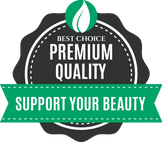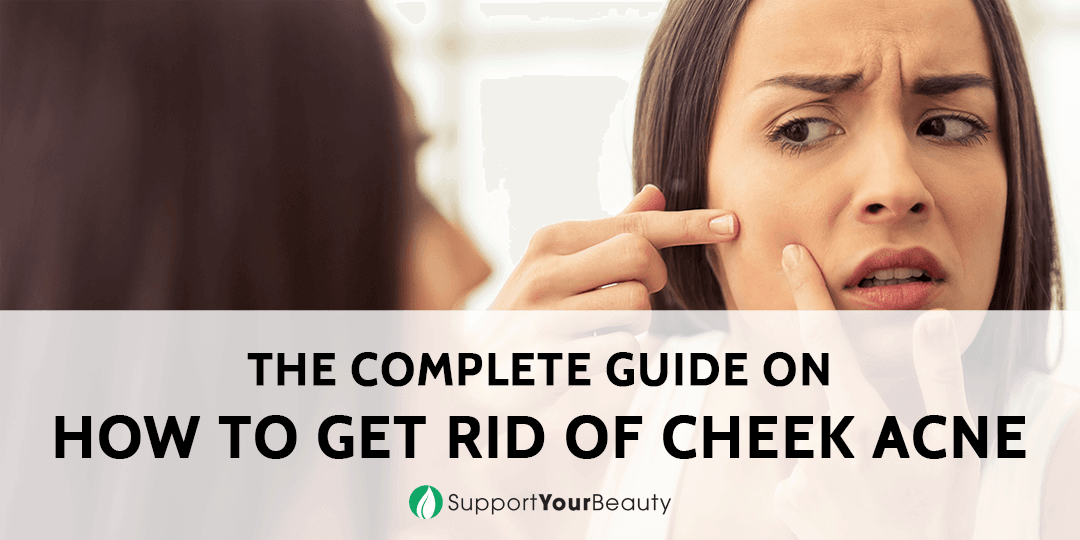
Stuck in the battle for clearing your face? Learn how to get rid of cheek acne to win this fight. We'll show you how to eliminate it forever!
The worst thing about cheek acne is that it’s easily noticeable, and it’s not that easy to hide either, compared to forehead acne. So it’s no surprise that you would want to get rid of it as fast as you can.
Much like facial acne, cheek acne starts with clogged pores. When skin pores get clogged up with dirt, excess oils, and dead skin cells, it can result in a little bump which can eventually rupture, causing bacteria to reach deep into the tissues and cause inflammation.
Luckily, cheek acne works the same way as other facial acne when it comes to treatments.
The only difference cheek acne has from other types of acne, such as chin acne or forehead acne, is what primarily causes it, which will be discussed further in the article.
More...
What Causes Acne On Cheeks
Now let's find out what causes cheek acne and how you can prevent it.
Great skin often starts from the inside-out. According to traditional Chinese medicine, your face is a window through which you can see your health.
With that being said, certain areas of your face in which you’re breaking out may entail that there’s something wrong with a particular organ in your body.
And as for the cheek area, it is directly linked to the liver, lungs, and mouth.
More specifically, the left cheek is mainly associated with the liver. As for the right side, it is more connected to your lungs.
But it doesn’t stop there. Breakouts in the lower parts of your cheeks may also signify dental problems.
However, there are still other contributing factors such as too much sugar in your diet, stress, over-exfoliation, and comedogenic products that are also the likely causes of acne breakouts on your cheeks.
1. You’re Smoking A Lot!
Not only is smoking bad for your lungs, but it also does terrible things to your skin.
According to traditional Chinese medicine, the right cheek correlates to your lungs, so it’s no surprise that smoking may be the source of your cheek acne problems.
When you smoke, you decrease the amount of oxygen to your face which can result in collagen and elastin degradation.
Collagen and elastin fibers give the skin its firmness and flexibility. So when these fibers break down, it can lead to saggy and wrinkled skin.
The carcinogens (cancer-inducing substance) in the smoke can also irritate and dry out your skin, which can trigger excess oil production making your skin more susceptible to clogged pores and acne formation.
2. Polluted Air!
When we breathe in dirty air, it can cause severe damage to our respiratory tract.
And because the right side of our cheeks is directly linked to our lungs, any harm experienced there gets paralleled on our cheeks.
So if you spend most of your time in the city, it’s no surprise you're always breaking out in the cheek area.
With continuous exposure to polluted air, not only are you damaging your lungs but also your skin.
3. You Have Poor Dental Hygiene
Surprising as it may be, breakouts in the lower part of your cheeks can indicate dental issues such as cavities, infections, or gingivitis (inflammation of the gums).
Poor dental hygiene is an interesting factor to consider if are unable to find a solution.
And because most people don’t stop to consider their dental hygiene as the source of their acne problems, it is often disregarded.
However, breakouts should not be the main reason to start taking care of your dental problems.
As much as possible, always stay on top of your dental health and don’t wait for breakouts on the lower part of your cheeks to arise before you go to the dentist.
4. Sugary Foods!
Acne breakouts on your right cheek can also be a symptom of too much sugar in your diet.
Although, sugar alone does not necessarily make you breakout; it can, however, add more fuel to the fire.
The oxidative properties of sugar are the ones making this happen.
Foods that are high in sugar and saturated fats can spike up your body’s insulin levels and cause inflammation of clogged up pores and result in acne.
High insulin levels can also trigger excess oil production which can contribute to clogged up pores and eventually turn into acne.
5. Too Much Stress!
Contrary to popular belief, stress doesn’t trigger acne. It can, however, make it worse.
When a person is under a lot of stress, the skin tends to produce excess oils, which, when mixed with dead skin cells and bacteria, can clog up the pores and lead to acne formation.
Too much stress can result in more acne, and so much acne can cause stress. It’s a never ending battle with stress and acne.
So if I were you, I would stop stressing about all the acne you’re getting and start getting rid of it.
6. You Over-Exfoliate!
Don’t get me wrong, exfoliation is the key to smooth, healthy-looking skin, but too much of it can cause more problems than you bargained for.
Over-exfoliation can cause temporary inflammation of your hair follicles which can then become infected with bacteria.
In these situations, it can become difficult to treat it with merely over-the-counter treatments.
However, if you do over-exfoliate, the most efficient thing to do is to just stop exfoliating your skin for at least two to three weeks.
By doing so, you’re allowing your skin to restore its natural epidermal barrier, so that it does not become infected.
How To Prevent Cheek Acne
The smartest way is to prevent it before it ever starts.
And to help you do so, we’ve listed down some incredibly useful tips on how to prevent cheek acne:
- Be mindful of anything that touches your face for an extended period such as dirty hands and phones because these can transfer pore-clogging dirt or bacteria to your skin and result in an acne breakout.
- As much as possible, try to use a hands-free device and avoid touching your face at all costs.
- Since you regularly press your phone on the side of your face, make sure to clean it daily with antibacterial wipes. Same goes for your pillowcases, make sure to change them at least once a week.
- Seeing as though your right cheek is directly linked to your lungs, make sure do breathing and aerobic exercises early in the morning to strengthen your lungs.
- Always keep on top of your dental health. Brush your teeth daily, use mouthwash, floss twice a day, and get regular check-ups at the dentist. Also, make sure that you will get enough calcium in your diet.
- Since the right cheek is sugar-focused, you might want to cut back on the junk foods, fizzy drinks, and sugary snacks; as well as wine, taro, and seafood.
- Avoid harsh exfoliants such as Apricot scrubs since they’re too sharp to exfoliate the skin, and will cause micro tears and over-exfoliation.
How To Get Rid Of Cheek Acne
For those unavoidable, yet unfortunate, cases wherein you still get cheek acne despite all your efforts in trying to prevent them, don’t worry we’ve got you covered.
You can get rid of cheek acne the same way you do with natural facial acne; that is with over-the-counter medications such as benzoyl peroxide, salicylic acid, sulfur, retinoids, and azelaic acid.
1. Benzoyl Peroxide
Benzoyl peroxide is one of the most commonly used acne treatment products around. It helps in unclogging skin pores and stopping bacteria from growing and causing acne.
On the first few uses, you may notice your skin getting red and peeling. No need to worry. This type of side-effect is completely safe and reasonable. Your acne will start improving in around four to six weeks, tops.
Benzoyl peroxide comes in different strengths in lotions, gels, soaps, and liquids. Look for products that contain 3% or less of benzoyl peroxide to avoid irritating your skin.
2. Salicylic Acid
Next to benzoyl peroxide, salicylic acid is just as effective in getting rid of acne. It helps correct the abnormal shedding of cells and unclogs the pores to prevent acne formation. However, it doesn't have any effect on the production of excess oils.
And unlike benzoyl peroxide, it does not kill bacteria that can potentially cause acne inflammation. Salicylic acid is available in many forms, including lotions, creams, and pads.
It must be used continuously, just like benzoyl peroxide, because its effects stop after using it. Pores clog up again, and the acne returns.
3. Sulfur
Don’t let the stink fool you! Sulfur is, in fact, one of the oldest known acne treatments. But luckily, today's sulfur skin care products don't smell that bad.
If you have sensitive skin, sulfur will work best for you. It’s widely known for being a gentle acne fighter because it works best on mild to moderate acne and isn’t quite sufficient for severe or cystic acne breakouts.
Sulfur acts like a sponge that draws out the oil in clogged pores. It dries out the pimples and reduces sebum production, helping to prevent future breakouts.
Sulfur can be found in a wide array of skin care products, including soaps and cleansers, lotions, masks, and spot treatments.
And just like with benzoyl peroxide, your skin may start to dry out, peel, and redden when you start to use any sulfur skin care product. And again, this is entirely reasonable.
4. Retinoids
Retinoids are some of the most proven, powerful and effective options for dealing with skin issues such as acne.
It helps in unclogging skin pores, treating oil production, getting rid of acne-causing bacteria, and reducing inflammation.
It also contains a high level of vitamin A, which helps speed up cell turnover and get rid of dead skin cells.
By preventing the build-up of dead skin cells, it can reduce the chances of clogged up pores that can lead to acne.
For cheek acne, try a retinoid cream. Apply it directly on the acne once a day 20-30 minutes after washing your face.
Breastfeeding or pregnant women should not, under any circumstances, use any retinoid products.
5. Azelaic acid
Azelaic acid is often used for treating rosacea; however, it is equally useful in getting rid of acne.
It works by inhibiting the growth of acne-causing bacteria and strengthening the cells that line up the hair follicles to decrease the chances of clogged up pores and prevent breakouts.
It’s also used in mopping up free radicals to reduce inflammation of acne lesions. Azelaic acid comes as a gel, foam, or cream.
It’s applied twice a day, in the morning and the evening. Follow the directions on your prescription label carefully and use it exactly as directed.
The Bottom Line
There you have it - a complete guide on how to deal with your cheek acne.
Cheek acne is just your typical facial acne. However, acne outbreaks on the cheeks may suggest that there’s something wrong with your liver, lungs, and mouth.
To avoid this, try to stay on top of your health because prevention is always better than the cure.
So as much as possible, try and avoid acne breakouts on your cheeks by following the tips given above.
But for those unfortunate cases, getting rid of cheek acne works the same way as treating common facial acne.
Just use the treatments given above, and that acne will be gone in no time.
Because even though cheek acne may be the most noticeable facial acne, it’s also one of the easiest to treat.

